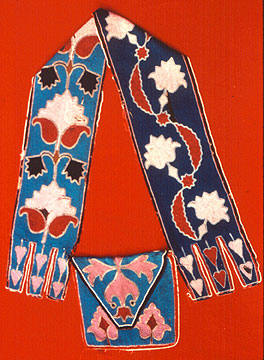 |
Octopus Bags
 |
Octopus bags were worn over the shoulder and across the chest. They carried a tool kit and other provisions a man needed when he went away from home to hunt or on business or pleasure trips.
They come in as wide a variety as the makers' imaginations. No two are exactly alike in design, color, materials, or techniques. The materials ranged from hide to broadcloth to finger woven yarn. After introduction by the French, Dutch, and English traders felt and woven woolens were used, Woven fabrics were often unraveled and reworked into a new cloth.
Designs changed over time, also. It is offered, as a best hypothesis, that after the arrival of the French, the designs of the Woodlands became distinctly floral in nature. Vining line replaced straight line. Leaves replaced diamonds and circles became flower centers and berries.
Embroidery silks, wools, and cottons as well as glass beads were adopted as they were introduced and came to replace dyed moose hair, maidenhair fern, porcupine quills, and bird quills.